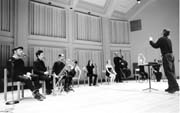Walter Thompson always had his roots in music, ever since he was a little boy. His father, Ron, who was born and raised in Weehawken, introduced his son to music at an early age while the family was living in Louisiana. “I’ve been a musician my whole life,” said Thompson, who is an accomplished woodwind performer and also plays the piano and percussion as well. “It’s always been a part of me.” About 20 years ago, while making his way as an orchestra conductor, Thompson happened to stumble across something that would change his life forever. “While I was conducting, I had a problem with some improvisation,” Thompson recalled. “Instead of yelling instructions to the orchestra, I started to make hand signs, gestures, that would tell the orchestra what to do. I just starting making up my own way of signing. At the time, the orchestra had no idea what I was doing. They just tried to follow my lead. But it’s developed over the years.” It has developed to the point that Thompson has devised a system of more than 700 different gestures that are used to conduct compositions, offering instructions to the musicians, dancers, actors, visual artists and poets that perform to certain musical pieces. Thompson, who has been a Weehawken resident for the last three years, has called his system “Sound Painting,” a name that he has trademarked. “Each gesture tells the performer the specific form of structured improvisation I’m looking for,” said Thompson, who just completed a seminar teaching his unique system at the New Jersey Performing Arts Center in Newark this week. “And I use the gestures to compose a piece on the spot. Sound Painting is a gesture that is not related to sign language. It’s just a way I’ve devised to communicate with the performers.” In its early stages, the system was used primarily to keep the improvisation as close to the style of the sheet music. But now, Sound Painting has evolved into a complete program, where an entire concert, dance or theater piece, film score or educational presentation can be realized spontaneously. “I know it sounds like a contradiction, structured improvisation,” Thompson said. “But there really is something to it. People wonder if it’s totally improvised. But it’s so structured that it’s improvised. A lot of it is left to the performer, but they have to follow the direction.” It definitely brings a fresh approach to conventional music, theater or dance. The performers asked to step away from their general fields of expertise and each is responsible for contributing improvised material. But just seconds before the conductor – or Sound Painter – calls upon the performers, usually 20 in number, to enter or exit the stage, the Sound Painter also places specific limitations on the improvisation. The performers have no way to predict the way the Sound Painter will lead the piece and must commit to each gesture without knowing where the piece may lead. “It can be done to a precise structure, like we’ve done Shakespeare or Gershwin’s ‘Rhapsody in Blue,’ ” Thompson said. “Or it can take on a mind of its own. It’s very crisp, like a collage.” Thus, the performance becomes more of a “Sound Painting,” than a concert. “It’s definitely unique,” Thompson said. “It’s not just strictly music. There are five different aspects going on. You really have to see it live to get it. Nobody understands unless they see it. But once they see it, they’re amazed. And everyone can do it. You don’t need musical talents. It’s very different from performance art.” Thompson added, “I’ve been a musician all my life and I’m befuddled how much the general public loves Sound Painting. You get the people standing and cheering. I think a good reason for that is that I always try to incorporate the audience, give them five simple gestures to use during the performance. They love feeling like they’ve done something to help.” The Walter Thompson Orchestra, based in New York City, has been performing through Sound Painting for the past 15 years. Thompson has been composing professionally for the past 25 years, performing and conducting his compositions nationally and in Europe. “We have orchestras in Texas, the University of Michigan, Berlin and Paris,” Thompson explains. Through it all, Thompson is also an educator and has been taking his Sound Painting theory to classrooms and seminars all over the world. Just recently, he completed a series with “high risk” teenage patients in New York’s Bellevue Hospital. He has taught composition and conducting at Eastman School of Music, The New School, MIT, NYU, University of Michigan, University of Iowa and University of Northern Iowa. He has just received a grant from the Mid-Atlantic Arts Foundation’s “Artist as Catalyst 2000” program to teach for the next month in three upstate New York public schools: the Ulster Green for Retarded Citizens, the Woodstock Day School and the Saugerties-Cahill Elementary School. “It’s all to see how we can incorporate Sound Painting into the music curriculum,” said Thompson, now 47 years old. “We’re taking the Sound Painting language into the classrooms.” And perhaps Thompson will be introducing the system into local classrooms as well. “I love it here,” Thompson said. “I would love to bring it here. It’s something that came up as part of necessity and now, it’s a way of life.” To learn more about the Water Thompson Orchestra and Sound Painting, visit their website at www.wtosp.org.
‘Sound Painting’: Music through gestures: Conductor brings unique method to classrooms, concerts
